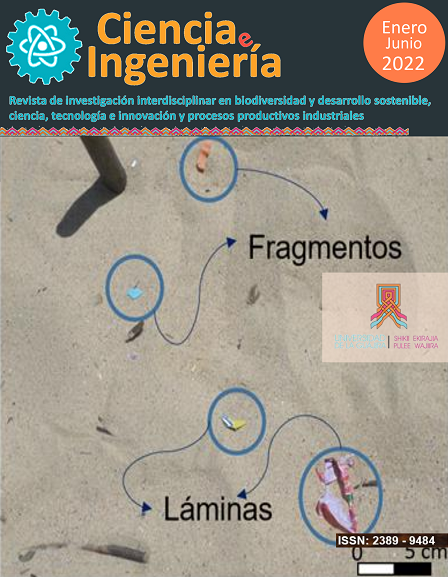Abstract
The leaf litter decomposition rates of three species of mangrove, Rhizophora mangle, Avicennia germinans, and Laguncularia racemosa, subjected to two treatments in a sector of the Ranchería river delta, were evaluated. Additionally, the composition of macroinvertebrates associated with these dynamics was determined. Significant differences in leaf litter decomposition rates were observed between species (p<0.05). A. germinans recorded the highest decomposition rates, followed by R. mangle and L. racemosa. When k values (g/day) were statistically compared among the mesh treatments, significant differences were found (P<0.05), from which it is observed that decomposition rates are faster in the big eye (MG) meshes. A total of 76 individuals of macroinvertebrates were found, Nerita sp was the most abundant with 41%, followed by Crassostrea sp, with 21%. The low abundance of macroinvertebrates associated with the decomposition bags did not show a clear effect of these organisms on decomposition. The decomposition velocities in the Rancheria river delta were high, allowing the processes of export to neighboring ecosystems and sedimentation to occur rapidly.
References
Álvarez-Sánchez J. Y Harmon M. (2003). Descomposición de hojarasca, hojas y
madera. En:Álvarez-Sánchez, J. Y Naranjo-García, E. (eds.) Ecología del suelo
en la selva tropical húmeda de México. Universidad Nacional Autónoma de
México. Instituto de Ecología.Pp. 108-122.
Alongi, D.M. (1990). Abundances of benthic microfauna in relation to outwelling of
mangrove detritus in a tropical coastal region. Mar. Ecol. Progr. Ser., 63: 53- 63.
Arbelaez, C, M. M; Hoyos, G, A. (2000). Zonificación ambiental de la media y baja
Guajira con base en los sistemas de información y geográfiota y la tele detección
espacial, Pag. 228.
Adaime, R. (1985). producción del bosque de mangles de Gamboa, Nóbrega. Tesis.
Universidad de Sao Paulo, Brasil.
Aké-Castillo J. G. Vázquez y J. López-Portillo. (2006). Litterfall and decomposition of
Rhizophora mangle L. in a coastal lagoon in the southern Gulf of Mexico.
Hydrobiologia 559: 101– 111.
Chale, F. M. M. (1993). Degradación de la hojarasca de manglar bajo condiciones
aerobias. Hydrobiologia, 257(3), 177-183.
Castellanos M., Carabalí., A. (2014). El delta del rio Ranchería: una mirada Biofísica y
social antes de la represa. Riohacha la Guajira, Pag. 95-135
Ciencia e Ingeniería 2022 Vol. (9) N.o (1) Hernández E. L. Granados S. CM., Fuentes R.J.
DESCOMPOSICIÓN ACUÁTICA DE LA HOJARASCA FOLIAR EN TRES ESPECIES DE MANGLE
EN LA DESEMBOCURA DEL RÍO RANCHERÍA (Brazo Riíto) Y SU RELACIÓN
CON LOS MACROINVERTEBRADOS EN EL MUNICIPIO DE RIOHACHA,
DEPARTAMENTO DE LA GUAJIRA
Dittmar, T., N. Hertkorn, G. Kattner & R.J. Lara. (2006). Mangroves, a major source of
dissolved organic carbon to the oceans. Global Biogeochem. Cy., 20: 1- 7.
Díaz-Fuenmayor, K. (2001). Regeneración natural del manglar en el Riíto y el Valle de
los Cangrejos, delta del río Ranchería. Trabajo de grado, Universidad de La
Guajira, Riohacha.
Eyes, M. (2010). Descomposición De La Hojarasca Y Su Relación Con Los
Macroinvertebrados Acuáticos En El Rio Gaira, Santa Marta, Colombia. Tesis
de Maestría En Ciencias Ambientales Linea Biodiversidad SUE Caribe.
Universidad del Atlántico.
Elosegi, A., Sabater, S. (Eds). (2009). Conceptos y técnicas en ecología fluvial.
Fundación BBVA, 444 pp.
Fernando, S. y S. Bandeira. (2009). Litter fall and decomposition of mangrove species
Avicennia marina and Rhizophora mucronata in Maputo Bay, Mozambique.
Western Indian Ocean J. Mar. Sci., 8: 173-182
Gattuso JP, Frankignoulle M, Wollast R. (1998. Carbon and carbonate metabolism in
coastal aquatic ecosystems. Annual Review of Ecology and Systematics, 29:405-
Hoffman A. (2005). Dynamic of fine particulate organic matter (FPMO) and
macroinvertebrates in natural and artificial leaf packs. Hydrobiology. 549:167–
Harmon, M. E., K. J. Nadelhoffer y J. M. Blair (1999). Measuring decomposition,
nutrient turnover, and stores in plant litter. 202-240. En: Robertson, G. P., D. C.
Coleman, C.
Hammer, Ø, D. A. T. Harper y P. D. Ryan. (2001). PAST:Paleontological statistics
software package for education and data analysis. Palaeontol Electronica 4 (1):
-9.
Hammer, Ø, D. A. T. Harper y P. D. Ryan. (2001). PAST:Paleontological statistics
software package for education and data analysis. Palaeontol Electronica 4 (1):
-9.
Instituto Geografico Agustin Codazzi. IGAC. (1988). Suelos y bosques de Colombia.
IGAC, Subdirección agrícola. Bogotá.
Lema-Vélez, L. Polanía, J. (2005). Regeneración natural y producción del manglar del
delta del río Ranchería, Caribe colombiano. Actual Biol 27 (82): 25-33.
Olson, J.S. (1963). Energy Storage and Balance of Producers and Decomposer in
Ecological Systems. Ecology 44: 322-331.
Panitz, CMN (1986). Producción e decomposição de serapilheira no mangue del rio
Itacorubi, Ilha de Santa Catarina, Florianópolis, Brasil (27 ° 35'S-48 ° 31'W).
Doctor en Filosofía. Tesis, Universidad Federal de São Carlos, São Carlos,
pp
Sierra-Rozo, O., J.E. Mancera-Pineda & A. Santos-Martínez. (2009). Velocidad de
descomposición de la hojarasca en diferentes sustratos de manglar durante la
época de lluvias en San Andrés Isla, Caribe colombiano. Boletín de
Investigaciones Marinas y Costeras 38(1):59-84.
Sánchez Páez, H. G., & Álvarez – León R. (1997). Diagnóstico y zonificación
preliminar de los manglares del Caribe de Colombia. Proyecto PD/171/91 Rev.
(f) fase 1. Conservación y manejo para el uso múltiple y el desarrollo de los
manglares en Colombia, Min Ambiente/OIMT/ACOFORE. Santa fe de Bogotá
D.C (Colombia) 511P.
Bledsoe, S. & Sollins, P. (Eds.). Standard soil methods for long-term ecological
research. Oxford University Press, Nueva York. 462 p.

This work is licensed under a Creative Commons Attribution-NonCommercial-NoDerivatives 4.0 International License.
Copyright (c) 2022 Luis Hernández Escobar , Cristian Granados-Martínez , Juan Fuentes-Reinés


